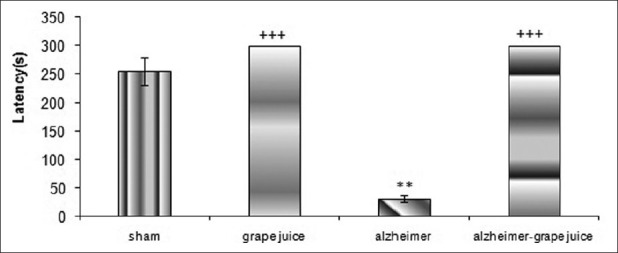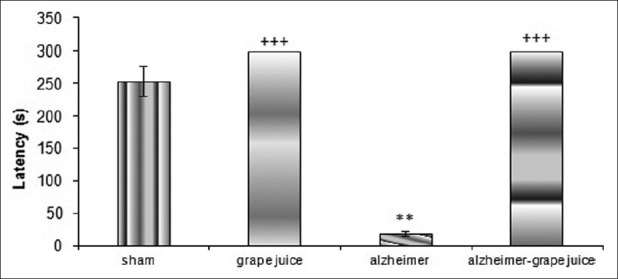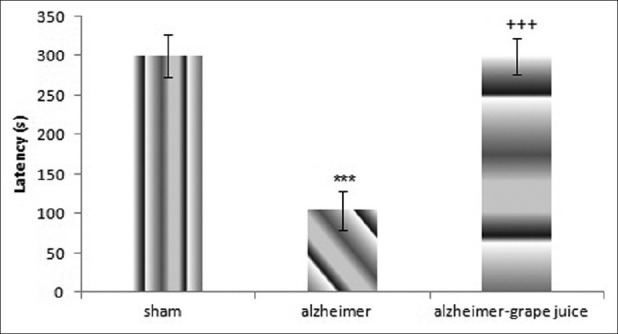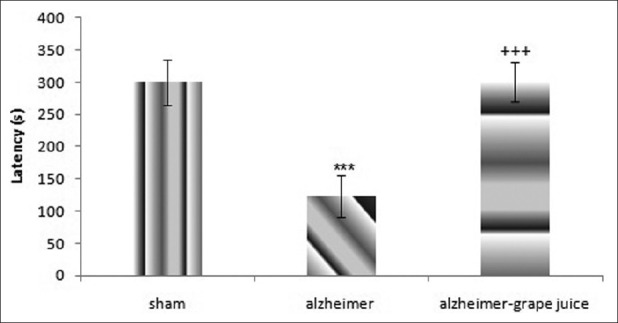Abstract
Background:
Alzheimer's disease is a neurodegenerative disease appearing as a result of free radicals and oxidative stress. Antioxidants agents boost memory and control Alzheimer's disease. Since red grape juice contains antioxidant agents, its effects on speed of learning and improvement of memory was studied in Alzheimer's rats.
Materials and Methods:
Alzheimer's model was induced by bilateral infusion of streptozocine into lateral ventricles of brain of male rats. Rats drank 10% red grape juice for 21 days. Passive avoidance learning test was used for measuring memory and learning in rats.
Results:
Our results showed that learning and memory in STZ-group decreased significantly compared to Sham group. However, intake of red grape juice increased speed of learning and improvement of memory in Alzheimer's rats.
Conclusions:
Our results suggest that there are active ingredients in red grape juice, which probably have therapeutic and preventive effects on cognitive impairments in Alzheimer's disease.
Keywords: Alzheimer's disease, avoidance learning test, red grape juice, streptozotocin
INTRODUCTION
Alzheimer's is a senile disease diagnosed with dementia and loss of neurons, especially in old people's brain.[1] This disease may be caused by oxidative stress; an imbalance takes place between free radicals and antioxidant system. Free radicals attack the unsaturated fatty acids of brain tissue cells and cause oxidative lesions.[2] Injection of streptozotocin (STZ) into the lateral ventricles of the rats’ brain reduces the sensitivity of insulin receptors to glucose and causes biochemical changes in glucose metabolism, which is followed by the oxidative stress; also cholinergic deficiencies occur by preventing ATP and acetyl coenzyme A synthesis, which results in cognitive deficiencies and memory impairment. This is accepted as a proper model for studying sporadic type of Alzheimer's disease.[3,4]
Recent studies have shown that consumption of fruit and vegetables, especially those with high antioxidant activity like grapes, strawberries, spinach, and cranberries decreases the risk for diseases caused by oxidative stress like Alzheimer's because they reduce the oxidative metabolism and subsequently reduce free radicals and can be effective in treatment of the disease.[5,6] According to the studies on some foodstuffs and beverages, these substances can both prevent the Alzheimer's and delay its progress. Some of these substances include aged garlic extract, sarcomin, melatonin, ginkgo biloba, green tea, fruit containing resveratrol, foods containing vitamins B, E, and C, salvia extract, zeatin, and grapes.[5,7–15] Based on the above studies, grapes and berry fruits with dark color have more efficiency in treatment of the disease. As seen for red wine, grape extract is a rich source of flavonoid polyphenols such as catkins, quercetins, anthocyanidins, proanthocyanidins, and also non-flavonoid polyphenols like resveratrol which all are active antioxidants effective in preventing or reversing the destructive effects of old age on the behavior and function of the brain.[5] Grape extract protects patients from low-density of lipoprotein cholesterol oxidation. Generally, grapes particularly red ones have a tremendous effect on memory boosting and even on Alzheimer's.[5,16] According to the above-mentioned findings, as various herbal essences are effective in Alzheimer's treatment and the effect of grape extract on learning and memory boosting in healthy rats and also reduction of destructive effects of oxidative stress on rats’ brain neurons and considering that the effect of grape pips and skin, not its juice. Alzheimer's treatment has already been studied; this study was conducted to evaluate the effect of grape juice on passive avoidance learning and memory in rats with Alzheimer's.
MATERIALS AND METHODS
Male Wistar rats (230 ± 20 g) were housed 4 per cage and maintained on a 12 h light–dark cycle in an air-conditioned constant temperature (23 ± 1°C) room, with food and water made available ad libitum. The Ethic Committee for Animal Experiments at Isfahan University approved the study. The red grape (Vitis Vinifera) juice was taken from gardens of Jahad-Daneshgahi in Baneh city, Kordestan Province, Iran. 70 rats were randomly selected and were divided into 2 groups of 40 and 30. The first group was divided into 4 subgroups of 10 rats named sham, grape juice, Alzheimer, Alzheimer-grape juice, and the second group was divided into 3 subgroups of 10 rats named sham, Alzheimer, Alzheimer-grape juice.
The rats of the first group were anesthetized by intraperitoneal (i.p.) injection of chloral hydrate (CH) of 400 mg/kg, and their body temperature was fixed using heating pads. Their heads were kept motionless in stereotaxic surgery device in order to do a longitude cut on the posterior part of the head to access the skull. Once the stereotaxic coordinates (AP = -0.8, DV = 4.2, and L = ±1.5)[17] were determined for the lateral ventricles of the brain, 2 holes were drilled on the skull and the injection cannula were inserted in the ventricles. Rats in Alzheimer's groups received a bilateral intracerebroventricular (ICV) injection of STZ (1.5 mg/kg, body weight in saline, 4 μl/injection site) as in previous studies, using a microinjection device and Hamilton syringe within 3 minutes.[2,3,18] Control groups’ brain ventricles were injected an equal volume of saline instead of STZ. The rats were put into separate cages after surgery, and they consume food and water ad libitum. 1 week after the surgery, the rats in the grape juice group received 10% grape juice-containing water, instead of pure water for 3 weeks.[5] Passive avoidance learning test was performed to examine learning and memory. The apparatus consists of 2 separate chambers connected through a guillotine door. One chamber was illuminated, while the other was dark. The floor of both the chambers consists of steel grids, used to deliver electric shocks. On the acquisition trial, each rat was placed in illuminated chamber while its back was to the guillotine door. After 10 s of habituation, the guillotine door separating the illuminated and dark chambers was opened. The guillotine door was closed immediately after the rat enters the dark chamber, and an electric foot shock with 1.5 mA intensity was delivered to the floor grids for 3 s, then the rat was removed from the dark chamber and returned to its home cage. 24 hours and 1 week later, retention latency time to enter the dark chamber was taken in the same way as in the acquisition trial, but foot shock was not delivered, and the latency time was recorded up to a maximum of 300 s. The longer latency for the first entry to the dark room indicates better learning and memory. The rats in the second group first received electric shock with the same time and intensity as those of first group. The next day, they underwent surgery in a way similar to the first group. Then, 1 and 3 weeks after electric shock, passive avoidance learning test was performed, and their learning rate was analyzed. Analysis of the data was done using the non-parametric method of Kruskal-wallis and the post-test of Dunnets at significance level of P < 0.05.
RESULTS
According to Figures 1 and 2, mean latency for the first entry to the dark room 24 hours and 1 week after the shock for the Alzheimer group was significantly less than that of sham group (P < 0.01), which showed the incidence of Alzheimer's in this group due to learning dysfunction and memory consolidation following the injection of STZ.
Figure 1.

Comparison of mean latency in Alzheimer and Alzheimer-grape juice 24 hours after electric shock using shuttle box device. The results showed that grape juice was effective in treatment of learning and memory dysfunction. (Mean ± SEM) **Comparison of Alzheimer group (n= 12) with sham group (n = 9) (P< 0.01). +++Comparison of Alzheimer-grape juice (n= 6) with Alzheimer group (n= 12) (P< 0.001). +++ Comparison of grape juice (n= 7) with Alzheimer group (n= 12) (P< 0.001)
Figure 2.

Comparison of mean latency in Alzheimer and Alzheimer-grape juice 1 week after electric shock using shuttle box device. The results showed that grape juice was effective in treatment of learning and memory dysfunction. (Mean ± SEM) ** Comparison of Alzheimer group (n = 12) with sham group (n = 9) (P< 0.01). +++ Comparison of Alzheimer-grape juice (n = 6) with Alzheimer group (n = 12) (P< 0.001). +++ Comparison of grape juice (n = 7) with Alzheimer group (n = 12) (P< 0.001).
As shown in tables and figures, latency for the first entry to the dark room 24 hours and 1 week after the shock for the Alzheimer-grape juice group was significantly more than that of Alzheimer group (P < 0.001). Furthermore, latency for the first entry to the dark room 24 hours and 1 week after the shock for the grape juice group was significantly more than that of Alzheimer group (P < 0.001).
According to Figures 3 and 4, mean latency for the first entry to the dark room 1 and 3 weeks after the shock for the Alzheimer group was significantly less than that of sham group (P < 0.001), which showed the incidence of Alzheimer's in this group due to the loss of memory location following the injection of STZ.
Figure 3.

Comparison of mean latency in Alzheimer and Alzheimer-grape juice 1 week after electric shock using shuttle box device. The results showed that grape juice was effective in treatment of impaired learning and memory storage. (Mean ± SEM) ***Comparison of Alzheimer group (n= 7) with sham group (n= 5) (P< 0.001). +++Comparison of Alzheimer-grape juice (n= 5) with Alzheimer group (n= 7) (P< 0.001)
Figure 4.

Comparison of mean latency in Alzheimer and Alzheimer-grape juice 3 weeks after electric shock using shuttle box device. The results showed that grape juice was effective in treatment of impaired learning and memory storage. (Mean ± SEM) ***Comparison of Alzheimer group (n= 7) with sham group (n= 5) (P< 0.001). +++Comparison of Alzheimer-grape juice (n= 5) with Alzheimer group (n = 7) (P< 0.001)
As shown in figures 3 and 4, latency for the first entry to the dark room 1 and 3 weeks after the shock for the Alzheimer-grape juice group was significantly more than that of Alzheimer group (P < 0.001).
DISCUSSIONS
In the present study, the effect of red grape juice on Alzheimer's disease, memory formation and consolidation, and learning in Alzheimer's was studied and the results showed that grape juice was largely effective in improvement of the memory function in Alzheimer patients and prevented the disease progress. This argument was based on the latency increase for the first entry to the dark room in Alzheimer-grape juice group and grape juice group than the Alzheimer group. As mentioned earlier in this study, intraventricular injection of brain was done in order to affect the rats with Alzheimer's. According to the studies in this regard, the injection of STZ into the lateral ventricles of rats’ brain causes oxidative stress and subsequently the progressive long-term defects in learning and memory and reduces reference and working memories. These animals whose memories are impaired in this way are used as a model for sporadic Alzheimer's disease.[4,18] Considering the presence of 2 groups in this study of which the first one was first affected with Alzheimer's and then received shock seemed that their retrospective memory (all the encoding and storage parts) was impaired and generally, the learning path and memory were impaired. In the second group, which first received shock and then affected with Alzheimer's seemed that first retrospective memory was formed and after getting Alzheimer, the prospective memory and retrieving part of the memory were impaired, and the memory location was destroyed and consequently the rats were affected with Alzheimer's.
The red grape juice is a really effective treatment for reduction of oxidative stress in central nervous system, memory consolidation, and the disease control due to its antioxidants-like resveratrol and flavonoid.[16,19] As the oxygen consumption in hippocampus and striatum is higher than other parts of the brain, the effect of oxygen reactive stems and free radicals is subsequently higher in these parts, which are more sensitive.[19] The protective effect of polyphenols in red grape depends on their ability of hydrogenation or cleaning up free radicals.[19]
CONCLUSION
According to the results of the present study on old rats, it was found that 20% red grape juice improved the performance of memory in passive avoidance learning test. Furthermore, generation of free radicals and the oxidative stress arising from oxidized protein and lipids in central nervous system, in some parts of the old rats’ brain, was higher than that of young rats. However, after the old rats consumed red grape juice containing antioxidants, free radicals were neutralized and the oxidative stress was reduced.[19]
A study on spatial memory and passive avoidance learning in rats affected with STZ-induced Alzheimer's showed that consumption of an antioxidant like coenzyme Q10 prevents learning and memory impairment through inhibition of oxidative stress caused by streptozotocin.[2,3] Epidemiological studies have shown that the consumption of red wine made of red grape containing certain polyphenols such as resveratrol and proanthocyanidin, declines age-related neuronal deficiencies like dementia.[20] These results suggest that red grape juice can largely be effective in Alzheimer's treatment due to its polyphenolic compounds-like flavonoids and resveratrols, which all are antioxidant as it prevented the impairment of different locations of memory-like hippocampus in the first group, and impairment of the parts related to retrograde memory in the second group.
Footnotes
Source of Support: Nil
Conflict of Interest: None declared
REFERENCES
- 1.Jee YS, Ko IG, Sung YH, Lee JW, Kim YS, Kim SE, et al. Effects of treadmill exercise on memory and c-Fos expression in the hippocampus of the rats with intracerebroventricular injection of streptozotocin. Neurosci Lett. 2008;443:188–92. doi: 10.1016/j.neulet.2008.07.078. [DOI] [PubMed] [Google Scholar]
- 2.Ishrat T, Khan MB, Hoda MN, Yousuf S, Ahmad M, Ansari MA, et al. Coenzyme Q10 modulates cognitive impairment against intracerebroventricular injection of streptozotocin in rats. Behav Brain Res. 2006;171:9–16. doi: 10.1016/j.bbr.2006.03.009. [DOI] [PubMed] [Google Scholar]
- 3.Ishrat T, Parveen K, Khan MM, Khuwaja G, Khan MB, Yousuf S, et al. Selenium prevents cognitive decline and oxidative damage in rat model of streptozotocin-induced experimental dementia of Alzheimer's type. Brain Res. 2009 Jul 24;1281:117–27. doi: 10.1016/j.brainres.2009.04.010. [DOI] [PubMed] [Google Scholar]
- 4.Lannert H, Hoyer S. Intracerebroventricular administration of streptozotocin causes long-term diminutions in learning and memory abilities and in cerebral energy metabolism in adult rats. Behav Neurosci. 1998;112:1199–208. doi: 10.1037//0735-7044.112.5.1199. [DOI] [PubMed] [Google Scholar]
- 5.Shukitt-Hale B, Carey A, Simon L, Mark DA, Joseph JA. Effects of Concord grape juice on cognitive and motor deficits in aging. Nutrition. 2006;22:295–302. doi: 10.1016/j.nut.2005.07.016. [DOI] [PubMed] [Google Scholar]
- 6.Dani C, Pasquali MA, Oliveira MR, Umezu FM, Salvador M, Henriques JA, et al. Protective effects of purple grape juice on carbon tetrachloride-induced oxidative stress in brains of adult Wistar rats. J Med Food. 2008;11:55–61. doi: 10.1089/jmf.2007.505. [DOI] [PubMed] [Google Scholar]
- 7.Frank B, Gupta S. A review of antioxidants and Alzheimer's disease. Ann Clin Psychiatry. 2005;17:269–86. doi: 10.1080/10401230500296428. [DOI] [PubMed] [Google Scholar]
- 8.Grundman M, Grundman M, Delaney P. Antioxidant strategies for Alzheimer's disease. Proc Nutr Soc. 2002;61:191–202. doi: 10.1079/PNS2002146. [DOI] [PubMed] [Google Scholar]
- 9.Jefremov V, Zilmer M, Zilmer K, Bogdanovic N, Karelson E. Antioxidative effects of plant polyphenols: From protection of G protein signaling to prevention of age-related pathologies. Ann N Y Acad Sci. 2007;1095:449–57. doi: 10.1196/annals.1397.048. [DOI] [PubMed] [Google Scholar]
- 10.Balk E, Chung M, Raman G, Tatsioni A, Chew P, Ip S, et al. B vitamins and berries and age-related neurodegenerative disorders. Evid Rep Technol Assess. 2006;134:1–161. [PMC free article] [PubMed] [Google Scholar]
- 11.Engelhart MJ, Geerlings MI, Ruitenberg A, van Swieten JC, Hofman A, Witteman JC, et al. Dietary intake of antioxidants and risk of Alzheimer disease. J Am Med Assoc. 2002;287:3223–9. doi: 10.1001/jama.287.24.3223. [DOI] [PubMed] [Google Scholar]
- 12.Pezzuto JM. Grapes and human health: A perspective. J Agric Food Chem. 2008;56:6777–84. doi: 10.1021/jf800898p. [DOI] [PubMed] [Google Scholar]
- 13.Heo HJ, Hong SC, Cho HY, Hong B, Kim HK, Kim EK, et al. Inhibitory effect of zeatin, isolated from Fiatoua villosa, on acetylcholinesterase activity from PC12 cells. Mol Cells. 2002;13:113–7. [PubMed] [Google Scholar]
- 14.Anekonda TS. Resveratrol--a boon for treating Alzheimer's disease? Brain Res Rev. 2006;52:316–26. doi: 10.1016/j.brainresrev.2006.04.004. [DOI] [PubMed] [Google Scholar]
- 15.Akhondzadeh S, Noroozian M, Mohammadi M, Ohadinia S, Jamshidi AH, Khani M. Salvia officinalis extract in the treatment of patients with mild to moderate Alz heimer's disease: A double blind, randomized and placebo-controlled trial. J Clin Pharm Ther. 2003;28:53–9. doi: 10.1046/j.1365-2710.2003.00463.x. [DOI] [PubMed] [Google Scholar]
- 16.Chui MH, Greenwood CE. Antioxidant vitamins reduce acute meal-induced memory deficits in adults with type 2 diabetes. Nutr Res. 2008;28:423–9. doi: 10.1016/j.nutres.2008.03.016. [DOI] [PubMed] [Google Scholar]
- 17.Paxinos G, Watson C. The rat brain in stereotaxic coordinates. 5th ed. San Diego: Academic Press; 2005. [Google Scholar]
- 18.Ishrat T, Hoda MN, Khan MB, Yousuf S, Ahmad M, Khan MM, et al. Amelioration of cognitive deficits and neurodegeneration by curcumin in rat model of sporadic dementia of Alzheimer's type (SDAT) Eur Neuropsychopharmacol. 2009;19:636–47. doi: 10.1016/j.euroneuro.2009.02.002. [DOI] [PubMed] [Google Scholar]
- 19.Emami M, Hosseini A, Saeedi A, Golbidi D, Reisi P, Alayi H. The effect of red grape juice on passive avoidance learning and memory in male rats. J Isfahan Med School. 2010;28:1–7. [Google Scholar]
- 20.Sarkaki A, Farbood Y, Badavi M. The effect of grape seed extract on spatial memory in aged male rats. Pak J Med Sci. 2007;23:561–5. [Google Scholar]


